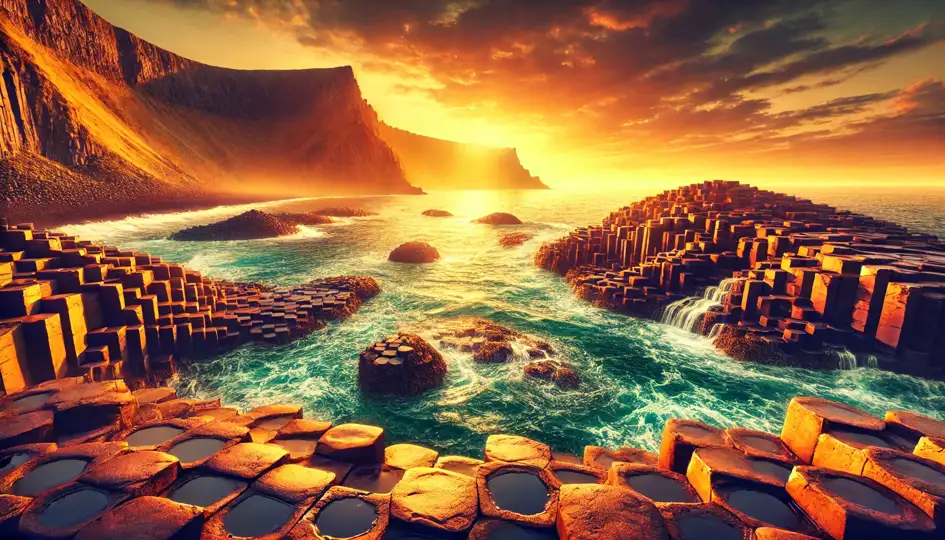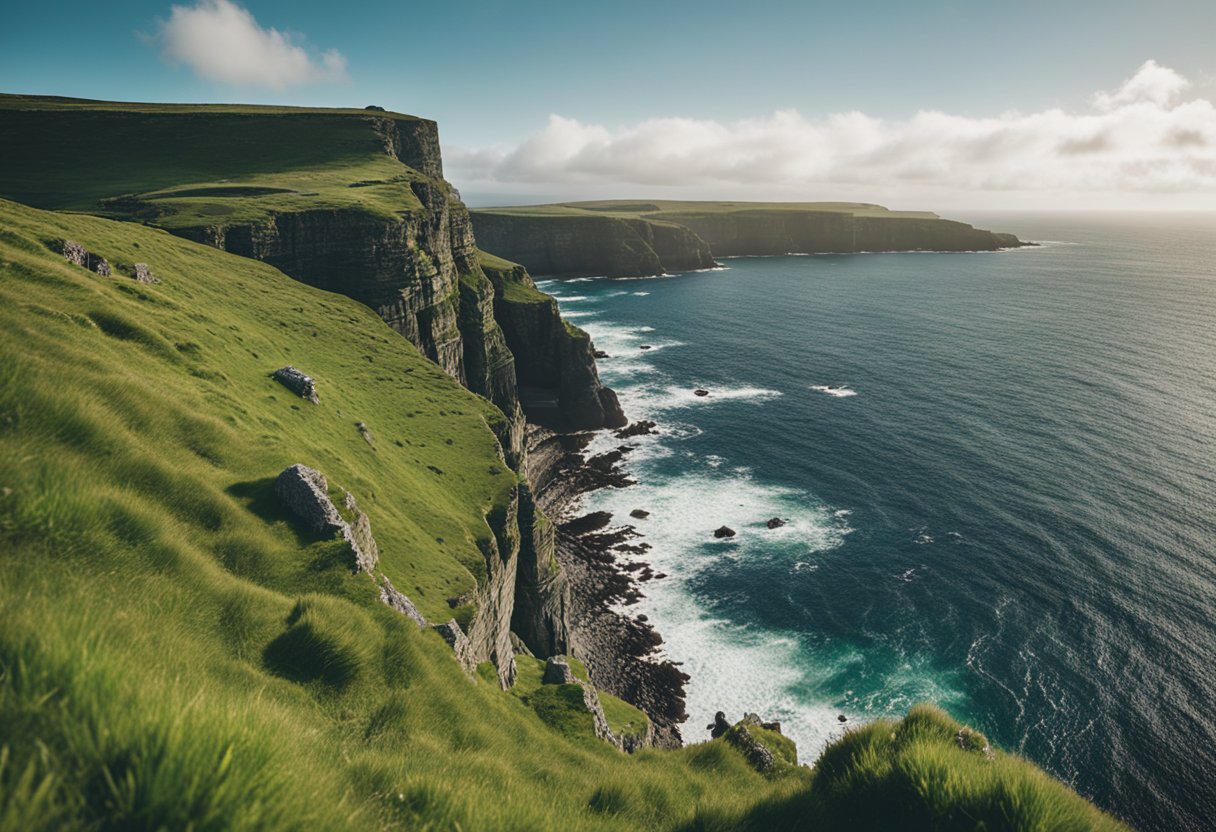In the Faroe Islands, where sea cliffs tower above the Atlantic and fog drapes over grass-carpeted hills, stories are more than mere echoes from the past — they’re a living part of daily life. From shape-shifting lake spirits and cursed seal women to trolls petrified by sunrise, these 18 wind-whipped isles cradle a mythology as wild and enduring as the landscapes themselves.
A horse in the mist
On the shores of Lake Sørvágsvatn, a lone horse appears to stand defiantly in the surf, its figure braced against the sharp Atlantic wind. But look closer and you’ll find something stranger — a sculpture of rock, steel, and imagination. This is the Nix, a mythical creature from Faroese folklore, said to take the form of a beautiful horse to lure humans into the depths of the lake.
“There’s always a way to break the spell,” local guide Elin Hentze explains, wind tugging at her coat. “Say his name before he drags you under, and he loses all his power.” We’re on Vágar, one of the 18 islands that make up this autonomous Danish territory. Towering cliffs and grass-tufted peaks give the Faroes a cinematic otherworldliness — not unlike the realms of Game of Thrones or The Hobbit. It’s easy to believe in monsters and magic here. And with Elin leading the way, I’ve come in search of the stories that shape these windswept lands.
Between sea and sky

As we skirt Lake Sørvágsvatn, a mist hangs over the water and sheep graze behind dry-stone walls. “This area is said to be home to huldufólk,” Elin says — the ‘hidden people’ of Faroese and Icelandic legend. “They live under the rocks, come out to dance, and sometimes take those who get too curious.”
Climbing higher, we reach Trælanípan Cliff. Below, the Atlantic hammers the rock face, fulmars surf the air currents, and the lake behind us appears to float high above the ocean. It’s an illusion, but everything here seems touched by enchantment. “When people were lost to sea or storms, they turned to myth for meaning,” Elin reflects. “You feel there’s a force bigger than you.”
But not all stories are fiction. Elin points to the very cliff beneath our feet. Slaves were once thrown from here by Viking masters when they grew old or ill. Centuries later, a woman disappeared hiking this same trail — never to return.
Trolls, tunnels and modern fables

Though human presence in the Faroes dates back 2,000 years, accessibility is relatively new. Remote villages once reachable only by boat are now linked by underwater tunnels — including the Eysturoy Tunnel, which boasts a roundabout 620 feet beneath the sea.
Driving through this subterranean network, I stop at Trøllkonufingur (“The Troll Woman’s Finger”) — a basalt spire as tall as the Eiffel Tower. Legend says Iceland sent a troll witch to steal the islands, but the sun turned her to stone. Only her finger remains. Eventually, the tunnels give way to ferries, and I find myself on Kalsoy, a long, narrow island that feels untouched by time. Here in Trøllanes — “Troll Peninsula” — just 13 people live among the hills, where it’s said trolls once partied every 12th night until scared off by a Christian prayer. “It’s easy to believe in dark stories here,” Elin murmurs as clouds loom overhead.
At the island’s tip, past the lighthouse clinging to the cliff, a modest stone marks the fictional grave of James Bond. Though Daniel Craig never set foot here, Kalsoy played backdrop to the spy’s final scene in No Time To Die — and now hosts both ancient myths and modern legends.
The woman who swam away
But Kalsoy’s most powerful story belongs not to Bond, but to the Kópakonan, or “seal woman.” Her statue rises from the rocks at Mikladagur: bronze-skinned, barefoot, with flippers laid beside her. “She was once a seal,” Elin tells me. “Each year, seals came ashore and danced as humans. A man stole her skin and forced her to be his wife. She bore him children — but one day, she found her skin again and escaped to the sea.” In revenge for her stolen life and murdered family, she laid a curse on the village. “To this day, if a man from Mikladagur drowns, locals say it’s because of her.”
Versions of the seal woman story echo across the North Atlantic — from Orkney to Greenland — carried by the sea and shared around hearths for generations. In 2021, Faroese artist and playwright Eyð Matras reimagined the tale as a one-woman performance. Over coffee in her harbour-side home in Klaksvík, she tells me: “It’s a story of control, of grief, and of reclaiming your wildness. We all come from that wildness.”
Art in the old town

That wildness is echoed in Tórshavn, the Faroese capital, where artist Heiðrikur á Heygum is painting the islands’ stories into permanence. His mural of squid, fish, and marine life wraps a whitewashed wall in the old town, and his illustrated folklore book is bringing forgotten legends to new eyes.
“These stories were always oral, passed through song or whispers,” Heiðrik says, flipping through watercolours of elfin figures and glowing-eyed horses. “Now, I’m just another reteller — the latest link in the chain.”
The warmth of storytelling
On my final night, I’m welcomed into the home of Anna and Óli Rubeksen in the village of Velbastaður. Ninth-generation sheep farmers, they host communal meals — part cultural exchange, part culinary celebration. As we eat roast lamb and rye bread by candlelight, the conversation drifts from Viking traditions to local ghosts.
“Before electricity, all you had were stories,” Anna says, eyes glinting toward the darkened window. “You looked out into the black, and your mind filled in the rest.” The myths of the Faroe Islands aren’t frozen in time — they live in the sea spray, in the shadows on a mountainside, and in the voices of those who still believe. Out here, on the edge of the Atlantic, legend feels like truth — and sometimes, truth is even stranger.
If you go
Getting there: Atlantic Airways flies from London Gatwick (May–August) and Edinburgh (March–December). Off-season, connect via Copenhagen.
Flight time: 1.5–2 hours direct.
Getting around: A hire car is essential. Vágar Airport to Tórshavn takes about 45 minutes.
Best time to visit:June–August is warmest (13°C) with long daylight hours, but busy. September is quieter and still mild. Puffins nest from April to August. Expect changeable weather year-round.
Where to stay:
Hotel Vágar, Vágar island – from £90/night
Hotel Føroyar, Tórshavn – from £95/night
More info: visitfaroeislands.com
Book a trip:
Where the Wild Is offers bespoke itineraries, including:
Classic Circle Self-Drive (8 nights from £1,700)
Summer Puffin Adventure (4 nights from £1,250)
Prices include accommodation and car hire; flights not included.




